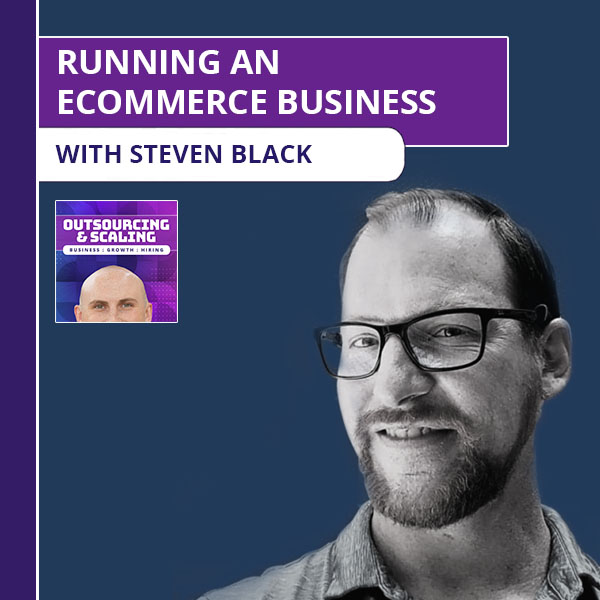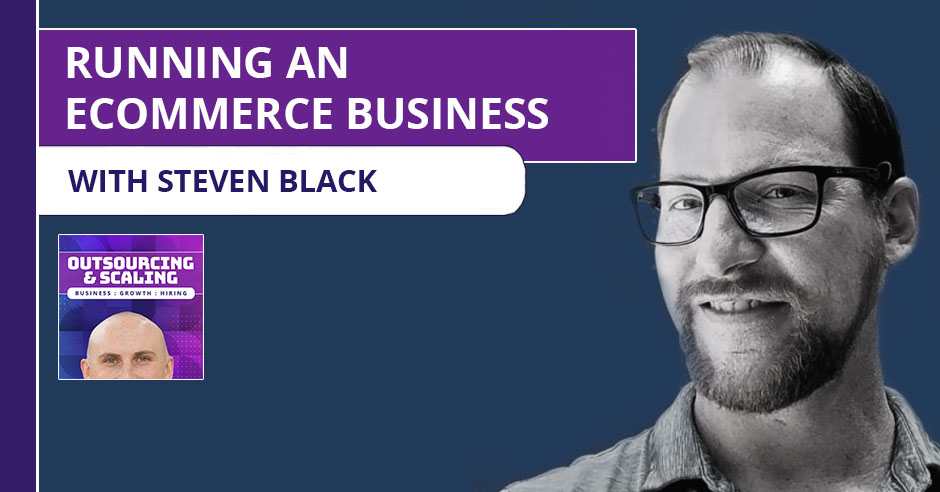


There are many ways of running an eCommerce business, but historically, some methods work better than others. There are certain ways out there that are just ultimately more effective at the end of the day, and if you’re running an eCommerce business, you should be getting in on those methods. Steven Black is a serial entrepreneur and has been a marketing expert for over ten years. He speaks with Nathan Hirsch about what makes an eCommerce business work, specifically on the organizational end. If you want to make sure that you’re running a tight ship, you shouldn’t miss Steven’s words of wisdom and generous tips.
—
Listen to the podcast here:
[smart_track_player url=”https://www.podetize.com/statsapi/www.podetize.com/wp-content/uploads/fileuploads/11-5b145ef137b51b3d1af0633e9305c43d/02/2020/0cddf75b9c08fed50b055b71c0378edc.mp3″ title=”Running An eCommerce Business With Steven Black” artist=”Nathan Hirsch” image=”https://freeup.net/wp-content/uploads/2019/04/OAS.png” ]
Download the audio file here.
Running An eCommerce Business With Steven Black
I am sitting here with Steven Black. Steven, how are you doing?
I’m doing very well, Nathan. I’m happy to be here.
I’m excited to talk to you. I know you and I have rescheduled a few times on each other. We’re both super busy. For those of you that don’t know, Steven has been a marketer for more than ten years. He’s a serial entrepreneur who’s owned several businesses and has built a number of brands both on and off Amazon. He spends a large amount of his time teaching, consulting for Amazon-based brands and works with companies of all sizes, including several eight and nine-figure companies. He now runs the Facebook group, Unstoppable FBA, which has over 8,000 people and he helps people become amazing Amazon marketers. You’ve probably seen him around if you’re in eCommerce or in the Amazon space, and we’re going to talk all about that, but first, let’s take a gigantic step back. What were you as a kid growing up? Were you a straight-A student? Were you a rebel? Did you always know that you wanted to be an entrepreneur?
No, I had no idea what I wanted to do. As a kid, I was very much the type that I was interested in what I was interested in and I wasn’t worried about what friends I had to pursue that interest. It’s if I was interested in something, I was going to go to the bottom of the rabbit hole until I was done with it myself. If I lost friends or if I won friends doing that, I did that. If it was when I was younger playing baseball or if it was a certain subject that I was into, I would do it. As an example, in high school, when everybody else was busy playing sports, I went nose deep into competitive bodybuilding.
I was the guy in high school that was always at the gym, always minding what I was eating. I wouldn’t go out and party. I shaved my legs and I competed on stage. From there, I got into the dancing ballroom and salsa and all that thing, dancing. It ended up being a career path for me once I got out of high school. It was right off to the races with that. That was me as a kid. Whatever I was interested in, whatever caught my eye and tickled my brain, I would investigate it and I wouldn’t worry about anything else aside from that. It’s how I am.
A lot of people getting into entrepreneurship do care what people think. I can tell that you don’t. I don’t either. I was selling baby products on Amazon for years and people thought I was crazy. Where does that come from? Is that something that one day you cared for and then one day not?
For me, I have had to provide for myself for quite a long time. I came from a very bad upbringing. We’re going to leave that there. There’s a lot that went wrong on the family side. I had to very quickly figure out what I was going to do for me because all of the things that you would normally think like going to your sporting events and whatnot, you’d say, “I want my family there to support me.” What if you grow up and you don’t have a lot of that? You get pretty used to saying, “I’m going to do it for me.” When you get in business or when you get a little older and you start having a family, I had kids in my early twenties. I was like, “I have to provide for them.” Nobody else’s opinion matters to that end. I’m not going to try to appease anybody else but that.
When you get into the business, you have to think of other people’s opinions, unless it’s your customers, are not going to pay the bills. Moreover, there are 7.5 billion people on the planet. That means 1% of those are 75 million people. You have to meet a new person every 30 seconds, 24 hours a day for 75 years to meet 1% of our population. If you piss a few people off, chances are you’re pretty strong to be able to recover. Do you stay true to your message, stay true to your gut, take your customer’s input and make them part of the process and improving your processes or customer service or even your product? That, as far as that goes, is all the people that you need to worry about. Everything else is replaceable.

I’d love to hear how you got into Amazon, how you got into eCommerce or how you built your first brand. Can you tell us a little bit about that story?
As I mentioned, I got into dancing when I was younger. Anything you can do attach to another human being is what I know how to do. I did it for a long time. I’ve traveled all over the world doing it, teaching people how to dance and dancing myself. I owned a couple of studios, but the problem was I was married to the studio. I couldn’t be a dad. I couldn’t have a life. I couldn’t do vacation because I was so concerned about making sure the studio ran. Even when I had other teachers under me to take the load of the lessons to be taught, I was married to the studio. I had other business owners that were students of mine and they were like, “How are you getting so many people in here?”
Because going out and actual dancing is not something that people think about. It’s a very small market, but I had 150, 160 people in my place every Friday night just for a party. I was shutting down the parking lot. I said, “I’ve got to figure out a way.” I started with some of those business owners and I started getting leads for them. They’re like, “If you can get us leads, we’ll come and take more lessons and we’ll circle it all back through.” I was like, “Fine.” I started getting them more leads and then I had an opportunity to get out. I shuttered it. By that time, I had a few websites up. I was running things on Shopify and all of that thing.
I’ve been investigating Amazon for a few years at that point but I never jumped in because I couldn’t give it as much time as I wanted to. By that time, I had already built businesses and been a marketer for about a decade before I got to Amazon. I decided I understand the process of looking at the audience first and coming up with a product from that unmet demand. Amazon is going to be one of my cashiers now. She’s a distribution point. What I did is I started with all of my winners that were my clear standouts that I was constantly having to reorder for my Shopify stores. I said, “Let’s send that up to Amazon first.” That’s where I took it.
I have a testing process in place because I run websites along all of my Amazon brands and when something stands out, now I send it to Amazon. The other thing is most people that talk about getting to Amazon private label that’s said you’re going to go to this tool. You’re going to put in these filters. Something’s going to spit out some product. You look for an opportunity. I completely disagree with everything. People say, “What’s your favorite tool for product research?” I said, “None of the ones you know.” Because if I’m looking for a pocket of unmet demand to be able to bring a product to market, if I’m looking for something that’s already selling well, there is a demand already being met.
If I want unmet demand, I have to go and do some social listening and say, “Here’s something that people are looking for, a variation of some variety, but nobody’s made it yet.” That means the sales numbers to show aren’t there yet because nobody’s brought to market. Let me work on that. Let me poke at them and ask questions, “If I took this and added this or changed it this way, what would you think?” You can do all that before you spend money. That’s how I’ve developed all the products that I have said. “You want it this way instead?” “I got it. Next,” and just rinse and repeat. That way I have a system that I test products against versus trying to get into a product and figure out how to sell it afterward. It’s much easier the first way.
Through this, you’ve built lots of brands. Were you doing a lot of it yourself or where you hiring people? Did you ever have an office? Was it all remote?
So far everything has been remote. I love being able to bring in people. Hiring for me comes down to time management, not cost management. A lot of people hire out of cost management first. I’m big on time management as well. For me, we figured out. This is the one or two things I need to handle every single day that keeps the business moving forward. Everything else, I need to figure out how to offload. The first thing we do is repetitive lower skill things. How can I offload those? What I do is instead of saying I need it done this way and the person doing it is a robot that breeds, so to speak. I say, “This is what I’m looking for. This is what I need to be done. This is the idea for the process. If you can make the process more efficient, do it. You own the end result.”
I try to pay people a little better because it incentivizes them and I give them a little more freedom to say, “This is the direction I want to go. You do that.” Even something as simple as dictation. If I hammer out some voice notes, I’m like, “I need you to type this up for me.” Whatever the process is on their end, whatever their workflow is, as long as they get it done, if they feel they have control over it and they’re appreciated for it, I don’t want to decide for them how they work. Let them do that part. That’s what I hired them for, so I don’t have to think about it. That starts lower costs and repetitive skills free up my time to grow the business. Then you say, “Who we’re going to be my specialists?” For me, I’m a writer. Graphic design is not my thing.
I hired a specialist and said, “I’m going to pay you well because I need you to be smarter at this than I am. I need you to own that whole thing. I need something this and I need this many of them for this reason. You do that, as long as the result comes back well, rock and roll. You own it. That’s your deal.” I make people own the results. If it’s bad, we got to talk about it. Maybe it’s something I communicated. Maybe their process is inefficient. I make them keep track of how they’re spending their time on the project because maybe they don’t realize themselves that they could make it more efficient. Even when I delegate a task, I ask somebody, “Can you trim this down a little bit and make it better? That’s what I’m hiring your expertise out for.” It’s always been an easy thing to find when you get people that freedom to put their brain the work.

Is there a certain type of person that you look for? What do you look for when you’re hiring people?
I look for people that are attentive. I don’t like hiring people that will say anything to get the task done. You’ll find attention questions on a hiring app with your questionnaire. You might sneak a question in there that’s not a question. You say, “At the end of this, I want you to tell me that you like pineapple on pizza to make sure you’re paying attention.” If they don’t, then you have to question everything else. Are you saying this because you need money? Are you saying this because you’re genuinely interested in the job? I try to give people an avenue to be dead honest with me. I also try to squeeze them into a position of contention because I want to know how they’re going to act under pressure.
I want them to be able to tell me that I’m wrong about something and that they see a different way. Even if we don’t see eye to eye, I want them to be able to say, “That’s not my experience. I think it should be this way and this is why?” If we can talk about the hard stuff and figure it out, bingo. Because that’s going to come up, the easy stuff, you can find anybody to work with. The hard stuff, let me squeeze you a little bit and say, “What if I needed it yesterday? What if I’m freaking out? You had a family emergency, how are we going to figure that out?” That’s how I try to try to figure people out that.
Avoiding people that are yes man or yes woman. My team leader, Jane, if she has a problem and I’m like, “Let’s do this,” I want her to say, “Have you thought about this way,” or “This way is a little bit better and why.” We can have a conversation and figure it out rather than, “I’m doing this because Nate said so.”
There’s a lot of people that are in a position where they will do any task that you give them and they can do it but they’ll do anything as long as they get paid for it. I don’t want those people. The graphic designer that I mentioned, if she catches me doing anything graphics-related, she will jump down my throat and say, “Why aren’t you typing something? Why aren’t you writing? Why aren’t you reading something to be creative? Stop doing my job for me. What are you procrastinating about?” I’m like, “You’re right. Off I go.” If I come to her with a bunch of new ideas, she’ll tell me, “Come back next week,” because she’s busy making our next seasonal sales stuff for our ads. She’s like, “Nope, get out of my face. No, I can’t talk to you for a week. Get out of here.” I’m like, “All right. You’re right. I’m going to go do me. I’ll come back next week. I told you to handle that first year. You own it. Love it.” That’s the idea. I’m the idea guy, but I take input from my team and I allow myself to be wrong. When you do that and you don’t think you have all the answers, everything grows because you stay in your lane of genius. That’s what the business is hinged around. That’s how I try to hire people.
A lot of great nuggets in there, staying within your core competency, focus on what you’re good at and surrounding yourself with other people that will take that initiative and get it done. Can you take us behind the scenes of one of your brands? What does that structure look like? How many people or do you have people managing other people? What different skillsets you have? The basic structure to give the readers.
First, you got to understand the model. My model’s a little bit different than everybody else. My model hinges around repeat business. I set everything up that way. I use Facebook groups, I use forums and I use social channels to make sure I can repeatedly touch people. Making content to regularly feed people and me touching people as the frontman for a brand is the main role. We got to clear my plate so nothing gets in the way of that. I’m a writer. I’m going to get up at 4:00 in the morning. I’m going to write every day. I love doing it. I would do it if I had no money. I would do it if I had every dollar in the world. I love it. It’s what I do. I love writing. I love talking to people. I’m not a Photoshop guy. I can do it, but it’s not my deal. What I’ll do is I’ll play with my team and I’ll say, “Here’s the season coming up. We need to figure out a sale for this. I got to make a content calendar for that. I’m going to have you handle the graphics.”
I have my personal assistant handle my scheduling. I’m going to go and I’m going to sit. I’m going to figure out the content. Everything else I can offload, if I can have somebody if I’m stuck and I have to go be dad somewhere, I have a few people I can say, “I need you to drop what you’re doing. I need you to type this out for me really quick and I’ll edit it back later. I’ll add stuff to it.” Because if I’m out and about, I’m in the car driving somewhere with one of the kids, I’ll rattle off something and a phone video, hand it to my assistant, she’ll get it to a typist. We’re done. That way, it still moves because I have an idea. Usually, I have me. I have my graphic designer. Sometimes I will bring on people to watch the ads, but usually, I’ll watch the paid ads myself. Now the other thing when you talk about most people thinks hiring is hiring people. I use a lot of software. For me, I use a program called Supermetrics that brings all of my information to a Google data studio dashboard.
I know what my Amazon brands are doing. I know what my Shopify stores are doing. I know my time management is doing. I know you know all this stuff I keep track of in Google Sheets. I usually have to do that. That’s not somebody that has to keep track of that. That’s a program that I pay for $25 a month that will say, “We’ll take all this data, all that reporting and we’ll put it on a dashboard for you so you can check the real health of all the orders and all the stores,” because that’s what I want to do. Instead of spending ten hours a week managing things, I spend an hour a day. It’s very easy. I said, “What happened yesterday?” My personal assistant will say, “Here are the problems,” because they have a separate email for that. Cool. I’ll handle those.
When it all gets moving, I have eight brands that I’m in charge of, which is a lot to keep track of. If I include all of the outsourcing, I sometimes outsource copies. Sometimes my graphic designer gets swamped and I have to outsource graphic designing. When it all starts moving, all of the assistants, all of the remote people, all of the outsourcing specialist we get up to where we 35, 36 people to keep it all moving the right way. That’s including full-timers, part-timers, remote timers, the whole bit. Can we run on less than that? Yeah, we can run on as little as seven but that stresses everybody out. We are a well-oiled machine and we’ll say, “Here’s the team meeting. We’re going to have this on this day. Everybody gets their projects. Go and we can talk on the back end if need be.”
There’s a book that I advise anybody to take a look at that will help people. It’s called Clockwork by Mike Michalowicz and there’s a time management thing in there called the 4Ds. It’s how you spend your time and it will help you figure out what the main role you should have in your business to make it survive and then how to transfer other tasks to other people and how to hire out people for that. When you should start hiring people for different things? Because the goal is not to be more productive and to cram more crap in the same time window. It’s to get more done in less time so that you have free time as a business owner. That’s what we’re after.

Honestly, people work themselves to death because they don’t take time to plan. What would I do with my free time? If you don’t have any idea what you would do with your free time, which is the goal of being an entrepreneur, you’re never going to make free time ever. You got to define that. That book spells it out. It’s very easy to read. It’s an exercise you could go over. That’s honestly what I do with my team. I have my time management that I keep track of and my graphic designer sometimes we’ll have four or five people under him at a time. I have him for another brand. I have two of them that work different brands. She’s the main one though and he’s in charge of two of the eight.
Let’s say it’s one of my print on demand numbers. I’ll say we have four or five people under you here. I don’t want just mine. I want to know what yours is. I want to know what that department is. How are you spending your time? Are you spending too much time meeting with each other to decide what direction to go? Are you spending too much time doing versus saying, “How can we make the system better?” Because that’s going to tell me the health of the company. Maybe we’re overdoing and not spending enough time considering our growth opportunities. Maybe we’re not addressing inefficiencies enough. If you keep track of it in each little department and then company-wide, it makes operational scaling much easier. Here’s the trick, if you want to scale a business, do not worry about spending more money. That comes as a byproduct.
You have to be able to build in risk capacity in both the people and the amount of work they can handle and how many assets you’re selling. It’s risk mitigation. When you increase capacity for risk, now you can worry about scaling because even if you fail, you’re still making a profit. Even if I take on more work, I still have people with work capacity. With a service-based business as an example, a lot of people were like, “We’re crushing it, so to speak. We’re making money.” What would happen if I gave you 50 more clients in the next week and a half? What would you do? Do you have a plan to operationally scale and say, “I know where the tasks would go?” If you don’t have that, you’re limiting yourself. I would say having an operational plan and scaling your capacity for work will naturally bring you more work and more money. It doesn’t mean more stress and more time involved. That means you can provide for other people. I know a buddy of mine started a graphic design company and now he has 60-something people underneath him, all remote, and they’re still looking to hire more people. It’s bananas. What we did is he knows how to operationally scale. If they get more work, he says I need more of this type of person. If you don’t know about that, you’re in trouble.
I want to transition into building a brand. That’s what everyone’s focused on with an Amazon business now. Both you and I were there back in the day when that didn’t matter on Amazon, although it sounds you were doing Shopify and other stuff at the same time where I was on Amazon. What do you see that’s working now when it comes to building a brand?
In building a brand, you need something. You have to have content that directs how people feel about your brand. You have to have a community, a place where people are going to talk about your brand. Beyond that, you have to be able to make offers to people and you have to have customer service to back that brand up. A lot of people, “build a brand,” but all they’re doing is dropshipping with a sticker from the Amazon warehouse because they’re not making an effort to work an audience. That’s not building a brand. Building a brand means when I see that label when I see that name, I have a certain feeling associated with it.
We’ve all been taught that Ferrari is a luxury supercar. Why? Because they have content for us to consume and they shape our opinion with it because there are communities of people that have Ferraris and that’s what they talk about. That’s a brand. If it was some box with a sticker that looks all the other products on Amazon, it’s not a brand. You don’t have customer service, you’re not directing the conversation and you’re not shaping people’s opinion, not leading them into buying. You’re not giving them more reasons to buy. You don’t have a place where people can talk about it. You’re not making conversation. That’s not a brand. That’s white-label drop shipping. That’s what it is. For me, what I have noticed in “building a brand,” if you want to build a brand, the monsters of brand building, they all have an audience.
You start with the audience. You are going to build a list. The reason that I beat on that is most Amazon sellers are so desperate to quit their 9:00 to 5:00 job. They don’t care who buys as long as they can get the person from zero purchases to one. A brand does everything they can to avoid that. You have to do that, but their focus is to get the person from one to two to three to four purchases, because of the money you’ve already taken in as the easiest money to make again. I promise you, if you improve your customer retention rate by 5%, you can increase your revenue by 90. It’s that easy, but you have to give them a reason to talk to you. You have to give them a place to talk to you.
That’s brand building. The brand is only as good as people’s sentiment about the brand. If you don’t know what people’s sentiment is and if you can’t keep track of that and if you can’t shape that, should it go sideways, do you have a brand? That’s the idea. A brand is a buzz word for me as far as the Amazon space goes because very few people have a brand. Look at their off-Amazon presence, look at what they’re creating. Look at how they’re driving the conversation. Your category dominators are not white label drop shippers. In a lot of them, Amazon is a singular channel. That’s what it is. I have a friend of mine and he’s in the teeth whitening space. They do $100 million a year. The company’s only a few years old. Amazon is one of their channels.
They have more traffic on their website than Crest. That’s a brand. They’re moving, but they do so much to drive the conversation and how did he do it? Is he an expert? Is he some orthodontist, mega dentist guy? No, it went deep. He figured out what it was. If you’re going to sell something and you want to make a brand, you’ve got to go deep on the topic. Become an expert. It doesn’t mean you have to go to college again. Read as much as you can and start by being everybody’s favorite newscast or bring them other people’s articles. “Have you guys seen this? What do you think about this? This is my thoughts on it.” All you’re doing is giving people something to talk about other than the sports scores from the weekend. If you do that, they will you and when you make a suggestion, they will buy from you. It’s pretty straightforward. That’s how you work a brand.
That’s such a good tip to quickly get an in. As we’re wrapping up here, any last marketing or Amazon tips, things that you think that is working now?
There’s a lot that works that has always worked but a lot of people don’t pay enough attention to it. I would say something that’s a very low level that people can do immediately. Spend some time off of Amazon learning how to do keyword research like somebody that does SEO work. If you can do keyword research and understand the broad phrase and exact and long tails and how long tails have more buying intent like a search engine optimization specialist would, and it’s not hard guys. It’s free information on Google and YouTube and Facebook. That will drastically improve your PPC efforts. That will drastically improve your listings because think about it, if somebody’s searching for men’s sunglasses. You’re page one for men sunglasses. It’s 40,000 searches a month but nobody cares because they’re not buying on that. If I get men’s bamboo sunglasses, I’ve had a descriptor. I know what I’m looking for. I want to buy something specific.
Maybe it’s lower volume, but it’s also much lower competition. If you start understanding how those keywords work, your costs will go through the floor. They’ll drop right out. It’s almost that’s next to nothing because nobody’s bidding on those lower volume, higher buying intent keywords. That’s the idea. People run their exact match campaigns and whatnot. I’m not going to put something in an exact match unless it’s for four words long in the phrase. Get out of my face with that because it’s higher buying intent, I’m going to pay more for it. I want it to convert higher, low-level tip, super gold. If you can start learning to do your keyword research as someone does for search engine optimization, you will start absolutely tearing people apart on Amazon because you’re making it easier for them to understand what it is, they’re buying. That’s the easiest tip there.

Steven, this has been great. Where can people find out more value and what are you most excited about for the future?
If you go on Facebook, you can look up Unstoppable FBA. I have a website of the same name, Unstoppable FBA. You can also look me up on Facebook. It’s Steven Black. I have a personal profile and a public profile where I put all my thoughts. If you need me, you can get me in either the group or you can message me through the website or on one of those pages. I’ll certainly respond. If you have any other questions, let Nathan know and surely he’ll get them to me. As far as the future goes, I have a very big honor. I’ve been invited to speak at an Affiliate World Asia in Bangkok, Thailand, which was 3,000 people. I’m also speaking at the Sellers World Conference in Bangkok, which is probably four or 500 Amazon sellers over there. Howard Thai is going to be there in a few other big names. I get to share the stage with them and I’m looking forward to helping more people. That’s what I like to do.
Check out Steven Black. He is one of the people to follow in the Amazon, eCommerce and marketing space. Definitely check them out on Facebook. I see him there all the time. I appreciate you taking the time. I know you’re super busy.
Nathan, thank you so much.
Important Links:
- Steven Black
- Unstoppable FBA – Facebook
- Clockwork
- Steven Black – Facebook
- Affiliate World Asia
- Sellers World Conference
About Steven Black
 I’m sitting with Steven Black. Steven has been a marketer for more than 10 years. He’s a serial entrepreneur who has owned several businesses and has built a number of brands both on and off Amazon. He spends a large amount of his time teaching and consulting for Amazon based brands and works with companies of all sizes including several 8 and 9 figure companies. He runs the Facebook group unstoppable FBA which is 8000+ people strong where he helps people become amazing Amazon marketers.
I’m sitting with Steven Black. Steven has been a marketer for more than 10 years. He’s a serial entrepreneur who has owned several businesses and has built a number of brands both on and off Amazon. He spends a large amount of his time teaching and consulting for Amazon based brands and works with companies of all sizes including several 8 and 9 figure companies. He runs the Facebook group unstoppable FBA which is 8000+ people strong where he helps people become amazing Amazon marketers.
